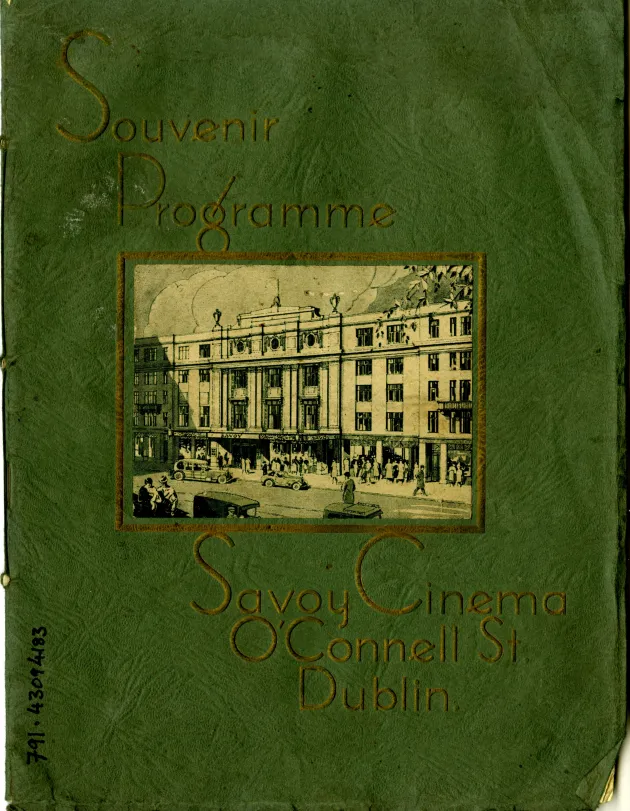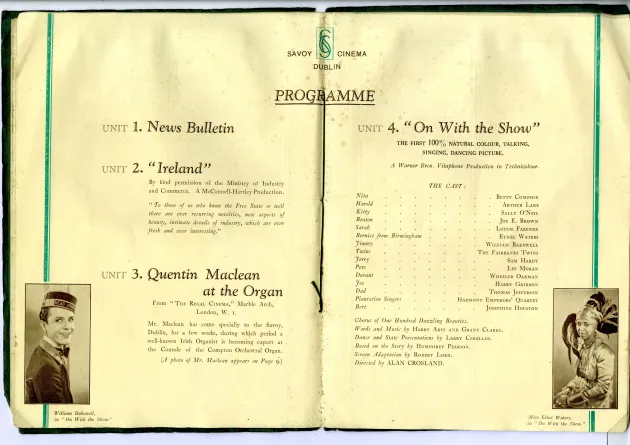The Savoy Cinema souvenir programme: opening ceremony November 29, 1929 by President Cosgrave
Published on 26th March 2024
There is a ritual to visiting the cinema: queueing for tickets; the smell of popcorn; the feel of the carpet under your feet; and the anticipation as the lights dim and the thick red curtain sweeps open. Film has the power to transport an audience to other worlds, other times, and other places. On a recent visit to Dublin City Library and Archives, I was struck by how the archive can also do this. There is a convention to visiting an archive too and once you are there, you can peek through a window into the past. An archival document has its own look, smell, and feel. It can bring you back in time and if you look closely, it has fascinating stories to tell.
One such document is ‘The Savoy Cinema souvenir programme’ from its opening ceremony on November 29, 1929. The Savoy was built on the site of the former Granville Hotel, which was destroyed in the 1916 Easter Rising. At the time “talkies” and colour film were making their mark, and this new and modern form of entertainment was seen as a lucrative market for savvy businessmen. The souvenir programme was produced to celebrate and promote the newly built Savoy as ‘a luxury Cinema worthy of this great city’. Reading through it, I was struck by two things. Firstly, the emphasis on the cinema’s modern, luxurious, state-of-the-art facilities and secondly, the repeated focus on the Irishness of the whole endeavour.

Image: Cover of Savoy Cinema 1929 Souvenir Programme at the Dublin City Library & Archive.
With its ‘steel-frame structure’ and ‘700 tons of cement’, latest technology was used in the Savoy’s construction. The interior décor was inspired by Venice and was designed to impress. It featured an azure blue ceiling, ornamental plasterwork, and an atmospheric lighting scheme in five different colours. The new Compton organ was installed on a movable platform that could be raised or lowered depending on whether the organ was in use or not. The restaurant and balcony on the upper floor could be accessed by either ‘broad marble staircases’ or ‘an electric elevator’. The building was configured with a back-up electricity supply in case the main one failed. Even if both failed, emergency lighting would be automatically powered by a 200-volt battery so that everyone could leave the building ‘in complete comfort.’ This was likely mentioned to reassure the public. Internationally, there had been many high-profile disasters in cinema buildings when fires broke out due to the highly flammable celluloid film and in the panic to exit the buildings, many lives were lost.
Similarly, the ventilation system was highlighted in the programme. It reads:
‘Every two minutes the whole of the air contained within the capacity of the Savoy Cinema is completely changed… replaced with air that has not only been washed, but also sterilised, purified and warmed, so that, as far as humanly possible, every patron at the Savoy Cinema will be breathing air which is as suitable and proper for human breathing as modern science can possibly render it.’
Bear in mind that Dublin had experienced the global flu epidemic of 1918 with huge loss of life and tuberculosis was a real and constant threat to the lives of Dubliners at this time. The Savoy was positioning itself as a safe place of entertainment that was also comfortable, opulent and fashionable.

Image: First page of Savoy Cinema 1929 Souvenir Programme at the Dublin City Library & Archive.
The Savoy was owned by a British company, Associated British Cinemas Ltd., but throughout the programme, it is at pains to demonstrate its Irish credentials to its Dublin audience – no doubt an important issue in a newly independent nation. It details how the construction provided employment to over 1,000 workers and stresses that ‘as far as possible, every position has been filled by persons of Irish nationality.’ Giving the cinema his seal of approval, the opening was performed by President of the Executive Council of the Free State (the Taoiseach of the day) W.T. Cosgrave. In his speech, reported in the Irish Times, he praised the external façade, a low-key Classical design which he felt added dignity to O’Connell Street. He also extolled the employment and tax revenue the cinema would go on to create for the State. As part of the opening programme the State film, Ireland, was premiered. This was a promotional tool for the country, showing sweeping scenes of Irish landscapes to be shown abroad to attract tourism. It seems that the Free State had budgetary issues on its mind.
The Savoy has changed a lot since 1929. The organ, the restaurant, and the Venetian atmosphere are long gone. But a record of it remains and reading through the souvenir programme in the archive gives a glimpse into what it and the Dublin of 1929 must have been like.
Credit: Dublin City Council Historian in Residence Katie Blackwood.
References:
‘New Savoy Cinema: Opened by President Cosgrave’, Irish Times, 30 Nov. 1929.
‘The Savoy Cinema souvenir programme: opening ceremony November 29th 1929 by President Cosgrave.’